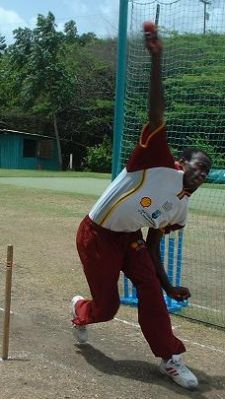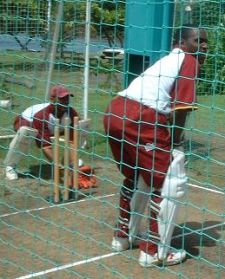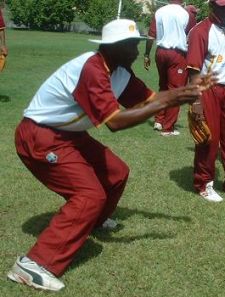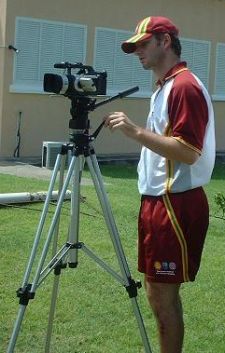Inside the Shell Cricket Academy
Fri, Aug 13, '04

Another session of the Shell Cricket Academy has ended and as a result of various media reports highlighting the apparent tension between the Academy's head, Dr Rudi Webster, and the WICB, West Indies cricket fans may still have questions as to the content of the programme.
In an attempt to give readers a better understanding of what the students are exposed to, I requested access to the Academy. I attended sessions on July 12th, 17th and 19th, and watched the young cricketers enthusiastically going through their paces both in the classroom and on the field.
This is an account of what was observed. But first, some background.
The Shell Cricket Academy at the St George's University (SGU) in South West Grenada is according to its brochure, "an annual, intensive three-month course for 24 of the region's finest young cricketers". This year, some changes were necessary because of various factors. The course was shortened to 10 weeks commencing 15 June, the last two of which are now being spent in Barbados on a tour playing competitive cricket.
The West Indies Cricket Board (WICB) issued a release which said, among other things, that "a number of the players who were being considered had already signed contracts for the current English season". The initial idea was doing away with the age restrictions, with a view to developing players for the Cricket World Cup 2007, however with the unavailability of players, the original method of nomination of players by territorial boards was used.
In addition, instead of 24 players, 17 players ranging in age from 19 to 22 years were initially announced, with one (Ryan Lane from Barbados) being added later. There was no explicit reason given for the reduced numbers this year.
The brochure lists among the facilities at the Academy, two bowling machines, six practice pitches (four turf and two all-weather synthetic pitches), a cricket ground with two centre wickets (not prepared this year), a gymnasium and modern fitness testing equipment along with video recording equipment and accompanying software.
Students also enjoy the use of the same facilities as the full time students of the University, including a modern computer lab and extensive library. The university has spent in excess of US$25 million to build this impressive campus. With money in abundance, it means that "the nets have a full time staff right throughout the year, even when the Academy is not in session," according to Barry Collymore, Operations Manager of the Academy. This is partly due to the fact that the facilities are made available to other teams. England was the latest International team to use the facilities, which they rated very highly, said Academy Director Dr Webster.
The broad programme content is documented in a contract between the SGU and the WICB, dated January 2001. Each year, a curriculum is developed using those broad outlines as a guide. This year, the curriculum was developed by the WICB Development Unit headed by Dr Michael Seepersaud, in consultation with Dr Webster.
The four pillars on which the programme was developed were (1) Cricketing Skills (batting, bowling, fielding, wicket-keeping); (2) Fitness; (3) Personal Development (including Literacy, Handling the Media and Money Management) and (4) Mental Skills.
By the time I got to the facility at about 8:15am on a Monday morning, the 18 aspiring West Indian cricketers had already been at their routine since 6:00am. The weekdays start with a gym session at 6:00am. Breakfast is from 7:30 to 8:30am and the first classroom session begins at 8:45am. The group is divided into three groups of six, and there is a collective responsibility enforced. If any player is late or otherwise guilty of an infraction, he and his group members are put on clean up duties usually for the week. Head Coach Roger Harper, who has gained a reputation as a disciplinarian, said "it's a group thing. They must be responsible for each other. They must make sure they get them here on time".

That morning's session was being lead by Dr Webster, and before he could begin, Lionel Baker, the promising fast bowler from the volcano-troubled island of Montserrat (and the apparent 'class comedian') quips "so Doc, you're not going to introduce the lady?" 'Doc' shoots back "Ok Baker, that's your job". He had been curious enough to turn to me before the session started to ask me who I was and where I was from, so he did a decent job of an introduction. Baker was sharp too to notice that the expiration date on my WICB pass was 30 June! Most grateful was I that he still allowed me to sit in.
Dr Webster reminded them of the importance of doing the 'Gilberto exercises'. These are a set of movements designed by Gilberto Liendro, who uses Kinesiology as a base for his fitness and physiotherapy sessions in his native Venezuela. The exercises are designed to "improve concentration, which will eliminate negative thoughts, and allow the cricketer to relax in order to be more receptive to self-suggestion and self-instruction".
Dr Webster reinforced that concentration is the most important element in a cricketer's arsenal echoing current West Indies coach Gus Logie's observations of what often goes wrong in West Indies matches. "If your mind is on the past, that is where you are. When the pressure is on, you can't focus. You think about the result ? the future ? instead of the next ball," lectured Dr Webster.

Next, 'Doc' as he is called by all, chose to use some real examples and practical exercises to illustrate the rest of the session's teaching points. He injected a bit of humour to keep the young men's attention and engage their minds. "Who is a Lara fan?" he asked. The Dominican all-rounder Liam Sebastien is known to his peers as one, so they nominate him. Dr Webster asks him to walk up to the front of the classroom, in the same manner as Lara would walk to the crease. A wiggle is involved. The class roars with laughter. "What does Lara do while waiting for the bowler?" asks Dr Webster. The answer is that he looks at the pitch twice then looks up. Why? "He previews it, and puts a mental image in his mind of what is about to happen," Dr Webster told the students.
Another exercise involved placing a marker at a length, getting the students to look at it, then close their eyes, walk towards it and pick it up. One student grabbed at air beside the marker. The class chuckled. Another picked it up effortlessly. His team mates applauded. Practice makes perfect so Dr Webster urged them to do those exercises on their own because judging the length is an important skills in batting.
More questions were thrown out to the students and as the young cricketers are a very animated bunch who seemed to get on well with each other, there was more good natured teasing and humour.
Here's the exchange between Dr Webster and Steve Liburd from St Kitts who captained the Leeward Islands U-19 team last year:
Doc: When a ball is coming, what do you focus on?
Steve: Whose ball? What speed?
Doc: Baker's ball
Steve: The writing on the ball!
The insinuation of course is that Baker's speed is slow enough for him to see the writing on the ball. Everyone smiles, including Baker who has the widest grin of them all.
Richard Kelly from Trinidad is the butt of another joke. 'Doc' draws a picture of a 'stickman' to demonstrate how once the brain picks up the trajectory of the ball, it calculates where it's going to land. The class pipes up "that's Kelly"! All good fun.
Gilberto arrived and it was now time to get serious...and quiet. The students were asked to take off their watches and stand in the centre of the room spaced out, in order of height with the shortest in front. Then they were made to do the "tree", the "cloud" and several more concentration exercises moving at the same speed as Gilberto. No apparent exertion was involved, but the cricketers were pouring with sweat in the chilly air conditioned room after the exercises. At one point, the Spanish-speaking Gilberto, who communicates mostly through Chris Parke who is the fitness instructor, admonished the students for not appearing to be serious. One minute they were grinning and the next minute they had to switch off that side and be serious. Now they knew what the saying "there's a time and place for everything" meant.
Dr Webster left them with the thought about Self-Acceptance. "You have to separate yourself from your performance and other people's criticism of your performance. Your level of confidence should look almost like a straight line," said Dr Webster. What is undesirable is a level of confidence that undulates like a series of hills and gullies. And it's not just criticism of one's performance that can upset the confidence level, but also effusive praise of it. In other words, don't let it get to your head, no, no, no.
It was now 11am and time for the morning's session to end. The players were given free time to unwind and get ready for lunch at 1pm. Let's see what's on offer.
Fish fried in a light batter, jerk chicken, spaghetti with mushroom sauce, rice, steamed vegetables and tossed salad ? all the makings of a well balanced meal. "A lot of time is spent with the caterers," said Webster, to ensure the nutritional needs are met. Many of the guys filled their plate with spaghetti as opposed to rice. Good idea because the energy would be needed for the afternoon's fielding session to be held at Grenada's New Queen's Park stadium. The youngsters were instructed to be on the bus by 2:30pm sharp. Anyone not there would have to find their way to the destination.
I had to give that a miss but turned up instead for two sessions the following Saturday and Monday in the nets at SGU. Several activities were observed over those two days.

There was catching practice where players were lined up opposite each other over about 50 yards and took turns making strong throws to each other. Then, Coach Harper, one of the most brilliant fielders in his day, showed the aspiring cricketers that he still has what it takes and would show up the present West Indian players for sure. With Ryan Lane as his partner standing about 8 feet from him, he repeatedly caught one ball in each hand just a split second apart. Understandably, Lane has a far way to go to match Harper's expertise in that area.
Darren Holder, the recently appointed WICB Coaching Manager under whose portfolio the Academy will fall from next year, filmed the fast bowlers in one net while Grenada national coach Ray Duncan jotted down the balls according to where they were bowled. Harper would later use this to review the performance with each bowler. In another net, the bowling machine was being used for Assad Fudadin.

There were also front foot drills with batsmen coming down the track to the spinners inside of a marked area, and driving along the ground. Very often you heard Harper shouting "on the ground, not in the air". Some batsmen kept on the back foot. Another opportunity to use Brian Lara as an example. To one player, Harper said "come on, be more dynamic. You ever see Lara, at 35, come down the track?" Harper turned a few standing in for one of the spinners who had gone to fetch a drink.
Warning. Cricket can be hazardous to your health. I wanted pictures for the photojournal, so I scurried closer to the nets and scurried back to a safe position even quicker. I asked the guys who were watching if they weren't afraid of being hit. "You have to get accustomed to always be watching the ball," said Steve Mahon, the former Grenada player. Give me a second pair of eyes then please, for with four nets going, that's what was needed!
Ricardo McFarlane was unfortunate to be hit on his left forearm by a ball. This gave one an opportunity to see the advantage of the Shell Cricket Academy being housed at a university which specializes in the teaching of Medicine. In a 'jiffy', the university's ambulance was on the scene and took McFarlane to the General Hospital accompanied by one of the University's doctors. He was back within one and a half hours. All it took were a few telephone calls by the Operations Manager. Thankfully, no broken bones or fractures were involved.

Ice baths are supposed to make a sportsperson's body feel good, and is used in the recovery process to prevent sore muscles. Under the sea grape tree sat a large Rubbermaid tub, the location for ice baths when needed usually after a particularly hard day's session. Hats off to Gareth Matthew, Richard Kelly and Queson Nedd who were the only ones to make it through the prescribed three 8-minute sessions. The rest could only muster 5 minutes at a time, according to fitness trainer Chris Parke.
There was a face missing when I went on the second occasion. It reappeared on the third. That was Hemnarine Harrinarine's. Having heard that his grandmother was dying, he made a request to be allowed to go back to Guyana to see her. Harrinarine received the news about his departure from Barry Collymore outside his dormitory where I was taken for a quick tour on my first visit.
A peek in the dorms revealed an ample size room for each cricketer, with a huge refrigerator. Central air conditioning is installed in all the university's dormitories. Six students share toilets, showers and a common area with cooking facilities, televisions (in most) and a large table.
So the students are kept constructively active from 6am to 5:30pm Monday to Friday, and from 9:45am to 12:30pm on Saturdays, learning new skills and techniques to enhance their game. This is what two of the students had to say about the programme.
Austin Richards, hard hitting Leeward Islands batsman who played for West Indies 'B' team in the 2004 Carib Cup competition:
The course has been a useful course so far in everything, especially the mental skills, training and some of the exercises from Gilberto. At the start I found them difficult but after you put your mind to it and a week or two weeks went by, you found them easy. They will help me a lot especially in my foot movement and my concentration.
I knew what my weaknesses were before I came here ? patience and concentration ? and I am working on them here. I have started to train my mind to be more patient and so far I am getting somewhere. I'm not fully there but I'm half way there.
When I go back I'll have to train myself to do the things I learnt here that I find working for me. I'm prepared to train myself. My goal is to reach the highest level, to play for the West Indies. I think I have a good chance based on the way I have been performing the past years and my ability. I played 4 games, ended up with 218 runs from 7 innings and scored 2 half centuries, no centuries. After this Academy session, I won't make just one century, but a lot more.
Kenroy Williams, Barbados batsman (awarded Most Highly Committed Player)
I think the programme is a hard programme but in order to succeed you have to do hard work. I think the net sessions and the facilities are very good. I think my cricket has improved a lot since I came here ? bowling, batting, my physical fitness, my mental fitness has improved a lot too. I concentrate better, even when I'm batting, I find that my concentration span is a lot longer and one time I used to lose it fast but since coming here I find that I've improved especially with the Gilberto exercises. I think those exercises are good things to learn because it helps your level of concentration. I didn't have training in this before. This has helped a lot. I practise the 'tree' and the 'cloud' and the meditation a lot.
The youngsters had more to learn. In the latter part of this year's abridged programme, there were scheduled to be sessions to address the Personal Development aspect of the curriculum mentioned earlier.
At the end of the programme, fitness tests in flexibility, strength, ply metrics, speed and agility as well as aerobic capacity were to be done. The results were to be compared with those obtained at the start of the programme to demonstrate how individuals had progressed. Then each player would receive a personal fitness programme to follow once back in their respective territories.
A full report is prepared at the end of the programme and sent to the WICB. Dr Michael Seepersaud has confirmed that the reports are sent on to the territorial associations. Included in that report are analyses and observations on each student. For the batsmen for example, the categories reported on include grip, stance, swing, feet, and fielding. These come under the Head Coach's report. Other information in the Director's overall report is what was done in each phase, a copy of the timetable, a report on the education component of the programme as well as recommendations for each player.
With any programme where individuals learn new skills, the trainer has to be concerned about transfer of skills and demonstration of the new behaviour learnt. What is to prevent these gentlemen from reverting to their old ways once they return to a familiar environment? Coach Harper is optimistic. "The enthusiasm and discipline, and the approach is much better than the guys last year". Asserts Collymore, the Operations Manager "when players go back, their attitude and their technique is better, that filters down".
It has to, or else somebody is wasting an awful lot of money.
But the question is, who will check? Who will monitor the players after they leave the Academy? "That's the responsibility of the WICB," said Harper. A tall order but very necessary if the aims of the Shell Cricket Academy's programme are to be fulfilled one of which is "to stimulate players to continue formal education, boost personal development and improve cricket and life skills".
As the sun sets on my third and final day, an Air Jamaica plane lands on the runway just adjacent to the university. In a few minutes it will come to a halt at its final parking position. Hopefully the Shell Cricket Academy will not be like this aircraft and grind to a halt, but that the stakeholders with a vested interest in seeing it succeed, will work on whatever issues still exist to ensure that it soars to the highest heights possible.